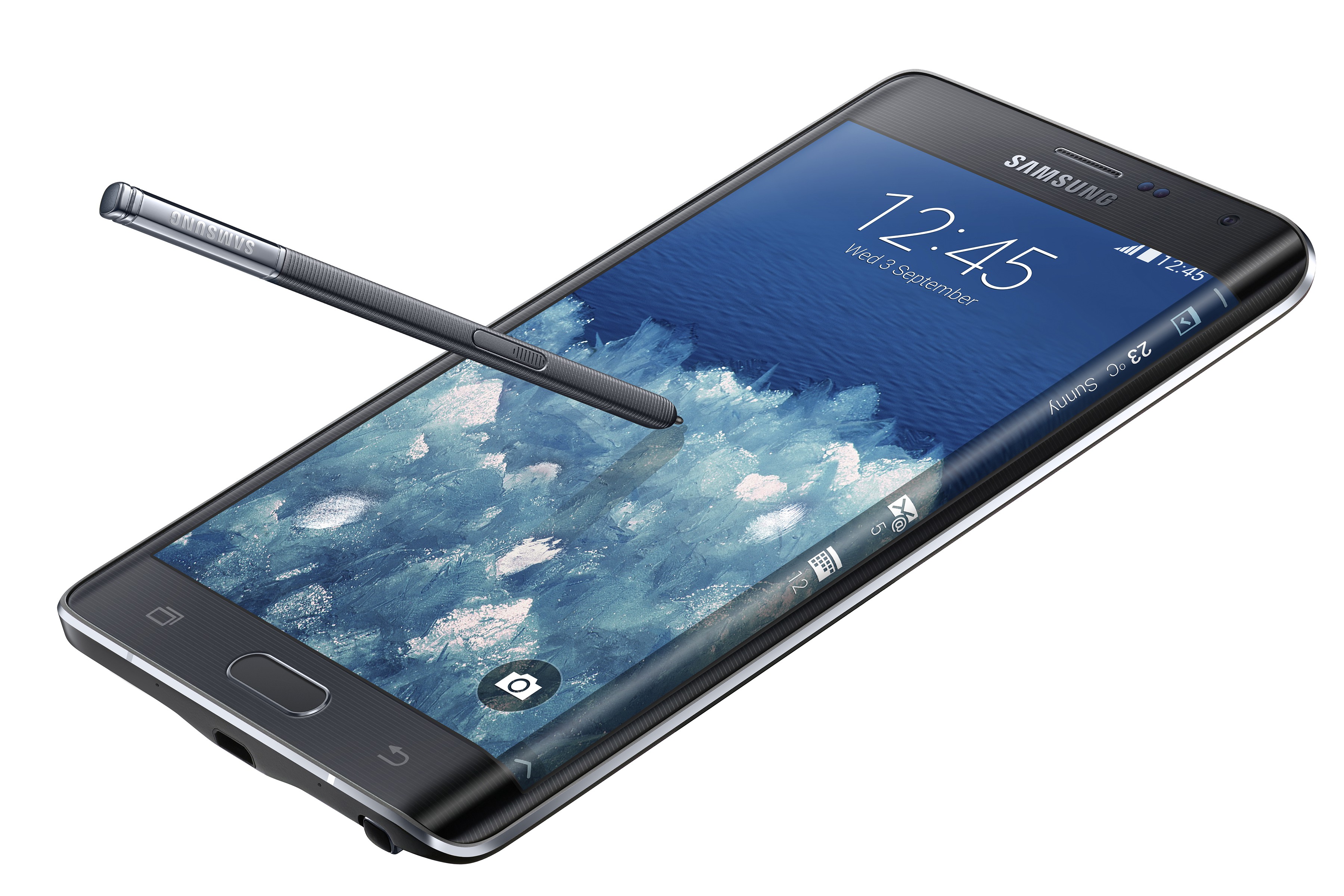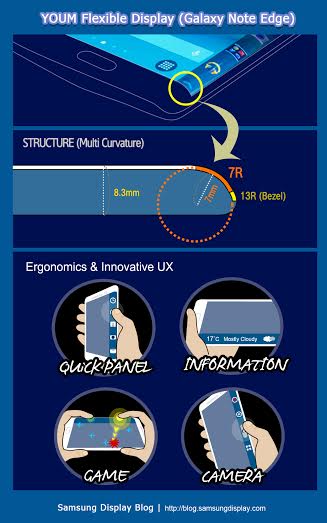Samsung Reveals More Details About Its Flexible YOUM Display
Two years ago at CES, Samsung unveiled its YOUM flexible display technology for the first time. Late last year, Samsung shipped the Note Edge, its first ever product to use the technology. At CES, this year, Samsung was also selected as an Innovation Award Honoree thanks to its YOUM technology.
Samsung first shipped a curved screen with the Galaxy Round, in October 2013, although that phone wasn't using YOUM technology. According to Samsung, the bended YOUM display represents a major leap forward for curved screens.
The new YOUM-based display in the Note Edge has a 5.6" diagonal in total, with 5.4" representing the flat surface. The curved edge is 7.5 mm wide, including the bezel. The display comes with a 2560 x 1600 resolution.
The bended part of the screen uses a multi-curvature design to make it easier to grip the phone. It can also be powered on or off separately from the flat surface of the screen, thanks to the AMOLED technology on which it's based, which allows Samsung to turn off or on individual pixels.
The bended side provides certain alerts and notifications, which Samsung believes are easier to see when keeping your phone in a case that can show the side of the unit.
According to Samsung, the Galaxy Note Edge display consumes 30 percent less power than the Galaxy Note 3 display, even though it has twice as many pixels.
Another advantage of the YOUM display is the higher durability with accidental drops, thanks to its high flexibility. This is a feature that Samsung hasn't tried to promote too much so far, even though almost every smartphone user who has experienced an accidental drop and resulting crack of a phone knows how important higher durability is. It could be argued that higher durability is, in fact, a much more important feature than being able to see your notifications from the phone's side.
Get Tom's Hardware's best news and in-depth reviews, straight to your inbox.
The reason Samsung is not promoting it too much is likely because the phone still comes with Gorilla Glass 3 protection, which isn't as durable on impact. The YOUM display on its own may be durable, but it's probably not very resistant to scratches, which is why Samsung must have decided to go with Gorilla Glass 3 on top of it anyway. If Samsung can figure out how to make phones with durable YOUM displays that don't break and don't scratch, it could be a game changer for the whole mobile industry.
Follow us @tomshardware, on Facebook and on Google+.
Lucian Armasu is a Contributing Writer for Tom's Hardware US. He covers software news and the issues surrounding privacy and security.
-
zero messiah Bended is a word. 'He offered his fealty on bended knee.' It is just not commonly used, and it does sound funny when it is used.Reply
-
someguynamedmatt Reply'Bended'... that isn't a word, 'Bent' is the correct word
Technically it is... the word is just archaic and is only used very rarely in modern context.
On that note, though, I don't see this as being a 'game changer' - more of a marketing gimmick if anything, and an unnecessary addition to manufacturing costs. Samsung tried to find a way for one of their units to stand out from the crowd of identical-looking smartphones, and this is the result we were given. I suppose it worked with all the press they seem to be getting around here.
I personally think that the marginal upgrades being put into a lot of these new handsets isn't even close to being worth a replacement... sure, I'm touched that you put a faster processor in it, but my LTE service is more of a bottleneck right now than the phone's actual hardware will ever be.
-
Solandri ReplyOn that note, though, I don't see this as being a 'game changer' - more of a marketing gimmick if anything, and an unnecessary addition to manufacturing costs. Samsung tried to find a way for one of their units to stand out from the crowd of identical-looking smartphones, and this is the result we were given. I suppose it worked with all the press they seem to be getting around here.
I dunno about it being a game changer, but it's not a marketing gimmick. The edge display fills a real need. Phablets are extremely popular in Asia among women. They slap a case on it and carry it around in their purses.
Unfortunately if they get a text, that means they have to pull the phone out of their purse and flip open the case to read it. Find out it's not an important text, close the case, and put the phone back in their purse. That's a lot of two-handed maneuvering just to find out it was an unimportant text.
The cases with a cutout window in the front (which kinda defeats the purpose of a protective case) were the first attempt at solving this problem. It eliminated the step of flipping open the case to read the text. But they still have to pull the phone out of their purse, and put it back in.
The edge display solves this problem entirely. Woman gets a text, opens purse, peeks at beginning of the text on the edge display while the phone is still in the purse, decides it's not important and closes purse. No need to pull out the phone. -
Reply
On that note, though, I don't see this as being a 'game changer' - more of a marketing gimmick if anything, and an unnecessary addition to manufacturing costs. Samsung tried to find a way for one of their units to stand out from the crowd of identical-looking smartphones, and this is the result we were given. I suppose it worked with all the press they seem to be getting around here.
I dunno about it being a game changer, but it's not a marketing gimmick. The edge display fills a real need. Phablets are extremely popular in Asia among women. They slap a case on it and carry it around in their purses.
Unfortunately if they get a text, that means they have to pull the phone out of their purse and flip open the case to read it. Find out it's not an important text, close the case, and put the phone back in their purse. That's a lot of two-handed maneuvering just to find out it was an unimportant text.
The cases with a cutout window in the front (which kinda defeats the purpose of a protective case) were the first attempt at solving this problem. It eliminated the step of flipping open the case to read the text. But they still have to pull the phone out of their purse, and put it back in.
The edge display solves this problem entirely. Woman gets a text, opens purse, peeks at beginning of the text on the edge display while the phone is still in the purse, decides it's not important and closes purse. No need to pull out the phone.
I guess the edge display is mostly for "cool factor" above all anything else, for usability wise I suspect it is negative in aggregate. I'm in Seoul, I has not seen many peoples having Note Edge or Note 4 yet, but many peoples have so called phablets. I think it's about at least 30% regardless of gender, for higher end it might be like 50%. Those are admittedly quite difficult for one hand use especially for women but they have purses so easier to carry at least. The more you use phones the better having larger screen.
-
tntom This is a novel way of adding more screen real-estate without making the device wider. Not sure why they are not marketing these benefits.Reply

